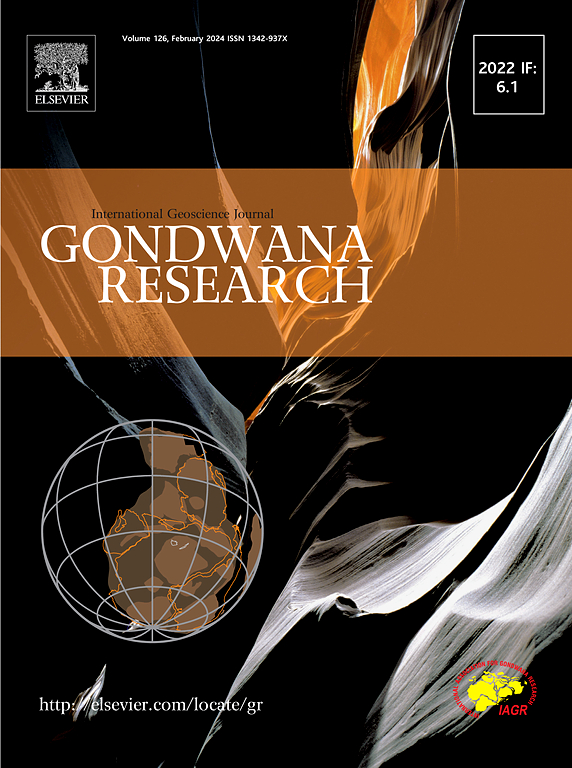Late Cretaceous invasion of Madagascan fresh waters by percomorph fishes (Teleostei: Acanthomorpha)
IF 7.2
1区 地球科学
Q1 GEOSCIENCES, MULTIDISCIPLINARY
引用次数: 0
Abstract
Numerous isolated elements from freshwater Upper Cretaceous (Maastrichtian) deposits in the Mahajanga Basin of northwestern Madagascar are identified as belonging to acanthomorph fishes. Multiple specimens representing the same bony element, including vertebrae, fin spines, basioccipitals, dentaries, hyomandibulae, anguloarticulars, and premaxillae (with a few other elements such as a vomer and a quadrate being less numerous), document the presence of several different morphologies that are indicative of at least three species. The morphologies of the elements, however, are broadly similar to one another, and we interpret this to be a reflection of their shared ancestry and identify the multiple species as representing a single lineage. Therefore, the material likely documents a single invasion of Madagascan fresh waters by a marine lineage, followed by the diversification of this lineage into several taxa within the freshwater environment. A less parsimonious scenario would be that the lineage may have diversified first in marine waters followed by several independent invasions of freshwaters by the most closely related lineages, which seems less likely. Most known Cretaceous acanthomorphs belong to Paracanthopterygii or early-diverging groups of Acanthopterygii, with few belonging to Percomorpha. The material reported here documents the presence of percomorphs in Upper Cretaceous freshwater deposits of Madagascar, the first from Eastern Gondwana and only the second from all of Gondwana. Additionally, the Madagascan acanthomorphs are much larger than most of those previously reported from Albian through Campanian marine and freshwater deposits, indicating that by the latest Cretaceous acanthomorph fishes had evolved relatively large body forms, at least in Eastern Gondwana.
晚白垩世表现形态鱼类对马达加斯加淡水的入侵(Teleostei: Acanthomorpha)
在马达加斯加西北部Mahajanga盆地的淡水上白垩世(Maastrichtian)沉积物中发现了许多独立的元素,它们属于棘形鱼类。代表同一骨骼成分的多个标本,包括脊椎骨、鳍棘、基枕骨、齿状骨、下颌骨、舌骨和前颌骨(少量其他成分,如舌骨和方骨数量较少),记录了几种不同形态的存在,表明至少有三个物种。然而,这些元素的形态彼此大致相似,我们将其解释为它们共同祖先的反映,并将多个物种确定为代表单一谱系。因此,这些材料可能记录了一个海洋谱系对马达加斯加淡水的单一入侵,随后这个谱系在淡水环境中分化成几个分类群。一种不那么简略的设想是,谱系可能首先在海水中多样化,然后是最密切相关的谱系几次独立入侵淡水,这似乎不太可能。大多数已知的白垩纪棘形动物属于副棘形动物或棘形动物的早期分化群,很少属于过棘形动物。这里报告的材料记录了马达加斯加上白垩纪淡水沉积物中表现形的存在,第一个来自东冈瓦纳,第二个来自整个冈瓦纳。此外,马达加斯加棘形鱼比之前报道的从阿尔比亚到坎帕尼亚海洋和淡水沉积物中发现的大多数棘形鱼要大得多,这表明到白垩纪晚期,棘形鱼已经进化出了相对较大的体型,至少在东冈瓦纳是这样。
本文章由计算机程序翻译,如有差异,请以英文原文为准。
求助全文
约1分钟内获得全文
求助全文
来源期刊

Gondwana Research
地学-地球科学综合
CiteScore
12.90
自引率
6.60%
发文量
298
审稿时长
65 days
期刊介绍:
Gondwana Research (GR) is an International Journal aimed to promote high quality research publications on all topics related to solid Earth, particularly with reference to the origin and evolution of continents, continental assemblies and their resources. GR is an "all earth science" journal with no restrictions on geological time, terrane or theme and covers a wide spectrum of topics in geosciences such as geology, geomorphology, palaeontology, structure, petrology, geochemistry, stable isotopes, geochronology, economic geology, exploration geology, engineering geology, geophysics, and environmental geology among other themes, and provides an appropriate forum to integrate studies from different disciplines and different terrains. In addition to regular articles and thematic issues, the journal invites high profile state-of-the-art reviews on thrust area topics for its column, ''GR FOCUS''. Focus articles include short biographies and photographs of the authors. Short articles (within ten printed pages) for rapid publication reporting important discoveries or innovative models of global interest will be considered under the category ''GR LETTERS''.
 求助内容:
求助内容: 应助结果提醒方式:
应助结果提醒方式:


